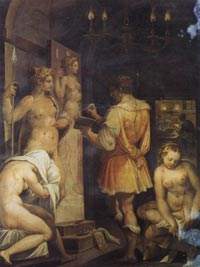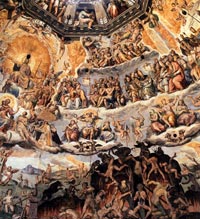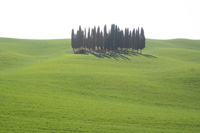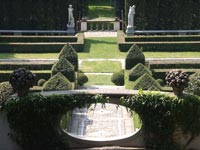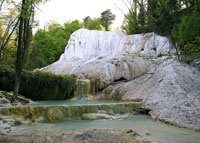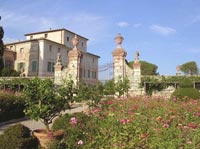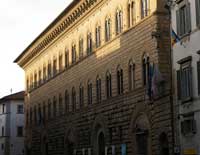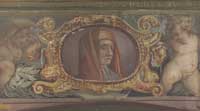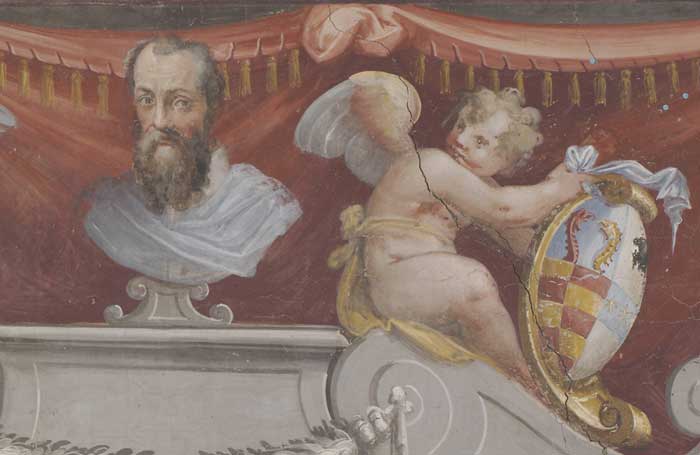 |
| Portrait of Giorgio Vasari (self-portrait?), north-west wall, state after cleaning of the paint surface and fixation of the coating, state during cleaning of the paint surface, Casa Vasari, Florence. |
Giorgio Vasari |
Giorgio Vasari (30 July 1511 – 27 June 1574) was an Italian painter, writer, historian and architect, who is today famous for his biographies of Italian artists, considered the ideological foundation of art-historical writing. |
As an architect, Vasari was perhaps more successful than as a painter. His loggia of the Palazzo degli Uffizi by the Arno opens up the vista at the far end of its long narrow courtyard, a unique piece of urban planning that functions as a public piazza, and which, if considered as a short street, is the unique Renaissance street with a unified architectural treatment. The view of the Loggia from the Arno reveals that, with the Vasari Corridor, it is one of very few structures that line the river which are open to the river itself and appear to embrace the riverside environment. |
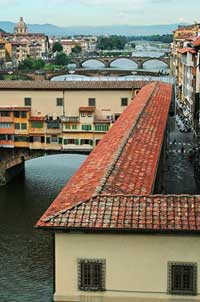 The West Corridor of the Gallery, heads towards the Arno and then, raised up by huge arches, follows the river as far as the Ponte Vecchio, which it crosses by passing on top of the shops. The meat market on the bridge was at this time trasferred elsewhere, so as not to offend the Grand Duke's sensitive nose with unpleasant smells on his walk, and replaced (from 1593) with the goldsmiths who continue to work there today. |
|
The most important example of Vasari's architecture is the Uffizi (Offices), commissioned by Cosimo I de' Medici to house the functions and records of his government and to impress Tuscans with the vastness of his bureaucracy. By unifying the regions's administration, the building expresses the political unity achieved by Cosimo. Its four stories line three sides of a space that is more like a street than a piazza. The Uffizi derives its effect from the repetition of elements: two Tuscan columns and a pier on the ground story, while on the second story a triplet of mezzanine windows alternates with Michelangelesque consoles. The third story features another triad of windows, and the open loggia of the fourth (now unfortunately glazed) reflects the Tuscan columns of the ground story. The only break in the uniformity comes at the end, where a central arch with a Palladian motif above it opens the vista in the direction of the Arno River. |
||
Uffizi Gallery |
||
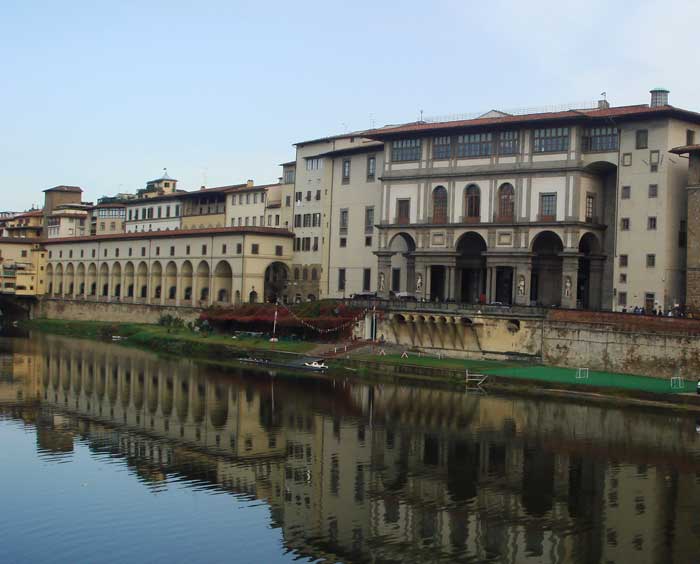 |
||
The Vasari Corridor and Uffizi Gallery, seen from the Arno River |
||
The Lives |
||
| As the first Italian art historian, he initiated the genre of an encyclopedia of artistic biographies that continues today. Vasari coined the term "Renaissance" (rinascita) in print, though an awareness of the ongoing "rebirth" in the arts had been in the air from the time of Alberti. Vasari's Le Vite de' più eccellenti pittori, scultori, ed architettori (Lives of the Most Eminent Painters, Sculptors, and Architects) — dedicated to Grand Duke Cosimo I de' Medici — was first published in 1550. It included a valuable treatise on the technical methods employed in the arts. It was partly rewritten and enlarged in 1568, with the addition of woodcut portraits of artists (some conjectural). The work has a consistent and notorious bias in favour of Florentines and tends to attribute to them all the developments in Renaissance art — for example, the invention of engraving. Venetian art in particular (along with arts from other parts of Europe), is systematically ignored in the first edition. Between the first and second editions, Vasari visited Venice and while the second edition gave more attention to Venetian art (finally including Titian) it did so without achieving a neutral point of view. Vasari's biographies are interspersed with amusing gossip. Many of his anecdotes have the ring of truth, while others are inventions or generic fictions, such as the tale of young Giotto painting a fly on the surface of a painting by Cimabue that the older master repeatedly tried to brush away, a genre tale that echoes anecdotes told of the Greek painter Apelles. With a few exceptions, however, Vasari's aesthetic judgement was acute and unbiased. He did not research archives for exact dates, as modern art historians do, and naturally his biographies are most dependable for the painters of his own generation and those of the immediate past. Modern criticism — with new materials opened up by research — has corrected many of his traditional dates and attributions. The work remains a classic, though it must be supplemented by modern critical research. Vasari includes a sketch of his own biography at the end of his Lives, and adds further details about himself and his family in his lives of Lazzaro Vasari and Francesco Salviati. Competition and "Competition" According to the historian Richard Goldthwaite, Vasari was one of the earliest authors to use the word "competition" (or "concorrenza") in Italian in its economic sense. He used it repeatedly, but perhaps most notably while explaining the reasons for Florentine preeminence, in the introduction to his life of Pietro Perugino. |
||
St Luke Painting the Virgin, fresco in Santissima Annunziata, Florence |
||
 |
||
Giorgio Vasari, St Luke Painting the Virgin, after 1565, fresco, Santissima Annunziata, Florence |
||
The sheer scale of his book, the Lives of the Artists reveals just how much Vasari did to dignify his profession and not just himself. He was acutely conscious of the roles the artist could play in a cultured society and he did his best to live as well as to promote the part. He was instrumental in founding the Accademia del Disegno in Florence in the early 1560s and contributed its keynote fresco, St Luke Painting the Virgin, to its chapel with the same dedication at SS Annunziata. |
||
Palazzo della Carovana on the Piazza dei Cavalieri in Pisa |
||
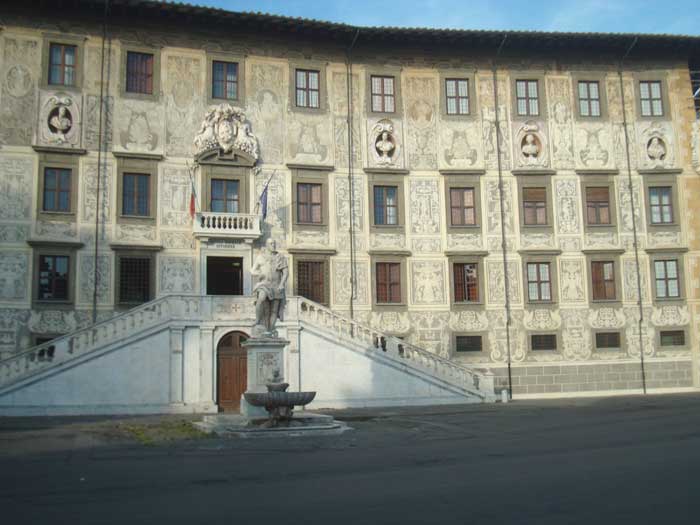 |
||
Pisa, Palazzo della Carovana on the Piazza dei Cavalieri |
||
| The Palazzo dei Cavalieri stands on the Piazza dei Cavalieri (Knights' Square) which was for many years the political and social centre of the city. The palace was originally the Palazzo degli Anziani (Palace of the Elders); then in 1562 Giorgio Vasari began the rebuilding and enlargement which produced the magnificent Palazzo dei Cavalieri or Palazzo della Carovana, named after the training courses for knights (cavalieri) of the Order of St Stephen which were held here; the courses were known as carovane (caravans). The imposing façade is decorated with sgraffito ornament, coats of arms and busts of six Grand Dukes of Tuscany (from Cosimo I to Cosimo III). The effect of the building is enhanced by the wide projection of the roof and the handsome double staircase leading up to the entrance. The decoration of the façade is also directed by Vasari. It is composed in three layers; the lower part is decorated with 12 constellation of the year, the middle with allegorical figures like Art and Virtue, and the topmost with the bust of the Medici Dukes, and at the centre, the famous emblem of the Medici family. Since Napoleon founded the Normal School in 1810 and gave the use of the building to the school, it is still occupied by the Scuola Normale The words sgraffito and sgraffiti come from the Italian word sgraffiare (”to scratch”), ultimately from the Greek γρ?φειν (gráphein), meaning “to write”. Graffiti, the bane of all modern cities in the form of spray paint, in its original sense refers to marks scratched onto a surface with a tapered point. The graffito technique has been used since prehistoric times. Decades ago, my father showed me graffito animals, birds and people carved on the tufa cave walls in northern New Mexico. But in Florence, starting in the 1400s, it was a technique of wall design, where the top layer of pigment or colored plaster is scratched through to reveal an underlying layer. The historian and artist Giorgio Vasari recorded the graffito technique step by step. First, one paints the wall of a palazzo with a layer of lime plaster, coloured with burnt herbs or other dark pigments. Once the first layer is dry, another is painted on, this time of white plaster, distributed uniformly. On top of this second layer are laid punched-out designs, or stencils, which are reproduced on the wall with powdered charcoal (referred to as tecnica dello spolvero in Italian). A tapered awl is then used to trace the resulting pattern on the wall, cutting through the layer of white plaster to reveal the darker, underlying layer. Thus, by using the same colours as a palazzo’s frescos, the graffito designs could be used to add shadow and depth to the overall decoration. |
||
|
||
Salone Dei Cinquecento, Palazzo Vecchio, Florence |
||
| With the growth of his stature and cultural ambitions when he was compiling and writing his book, the Lives of the Artists, the nature of Vasari's commissions fundamentally altered in the final thirty years of his life, from individual works such as altarpieces to grand enterprises in different media requiring a controlling hand over a large body of assistants. To accomplish these great projects he organized a vast workshop on a scale unprecedented in Florence. Many of his pictures still exist, the most important being the wall and ceiling paintings in the great Sala di Cosimo I of the Palazzo Vecchio in Florence, where he and his assistants were at work from 1555, and the frescoes he started inside the vast cupola of the Duomo, completed by Federico Zuccari and with the help of Giovanni Balducci. The best example of the grand enterprises are the ceiling and walls of the main room, the Sala del Cinquecento, completed 1565. The ceiling is divided into 39 panels depicting episodes from the history of Florence and the Grand-duchy of Tuscany. Along the upper part of the walls are battle scenes by Vasari, below are a series of statues and marble groups. |
||
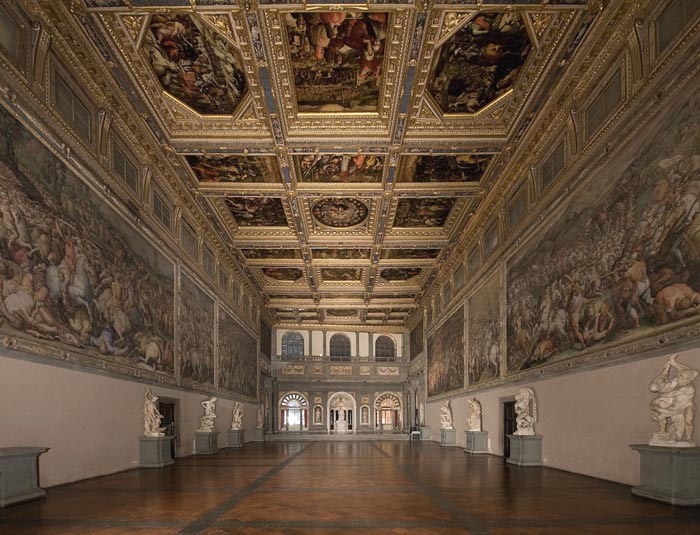 |
||
Salone Dei Cinquecento |
||
The massive Salone dei Cinquecento (Room of the Five Hundred) once held the Council of the Five Hundred, a governing body created by Savonarola during his short stint in power. The long room is largely decorated with works by Giorgio Vasari, who orchestrated the redesign of the room in the mid-16th century. It contains an ornate, coffered and painted ceiling, which tells the story of the life of Cosimo I de' Medici, and, on the walls, gigantic depictions of battle scenes of Florence's victories over rivals Siena and Pisa.
Leonardo da Vinci and Michelangelo were initially commissioned to produce works for this room, but those frescoes have been "lost." It is believed that Leonardo's Battle of Anghiari frescos still exist beneath one wall of the room. Michelangelo's Battle of Cascina drawing, which had also been commissioned for this room, was never realized on the walls of the Salone dei Cinquecento, as the master artist was called to Rome to work on the Sistine Chapel before he could begin work in the Palazzo Vecchio. But his statue Genius of Victory located in a niche at the southern end of the room is worth a look. |
||
|
||
|
||
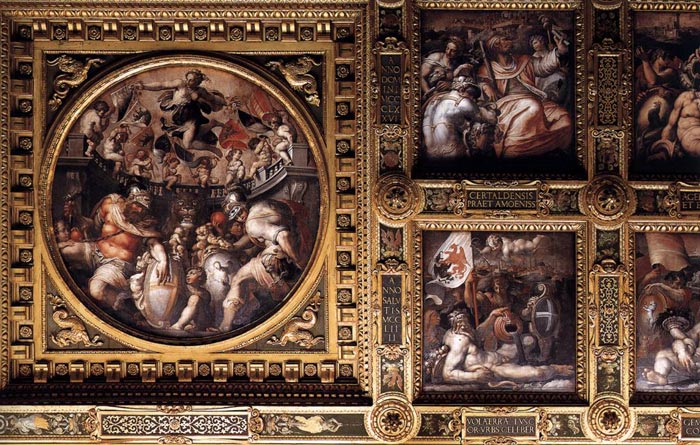 |
||
Giorgio Vasari, Salone Dei Cinquecento, ceiling decoration, completed 1565, oil on canvas, Palazzo Vecchio, Florence |
||
Vasari had a well disciplined army of assistants, and with their aid he was able to cover numerous Florentine and Roman walls and ceilings with frescoes and oil paintings. While these are often unreal and pompous, they seldom lack decorative effect or historical interest. Enormous altarpieces from his studio line the side aisles of Florentine churches, vast battle scenes and smaller decorative works fill the halls and smaller chambers of the Palazzo Vecchio. In the centre the scene of Cosimo's Return from Exile in 1434 is depicted, while other episodes from the life of Cosimo the Elder are around.
The decoration of large halls with the deeds of the nobility and their ancestors was intended to inspire the viewer's admiration. The depiction of such events from the recent past has a long tradition. Most such cycles in the first half of the sixteenth century, however, are dedicated to a single person or event. By contrast, from the middle of the century onward this genre was increasingly devoted to the representation of dynasties. The first steps in this direction were taken by a family that did not belonged to the old aristocracy, but knew enough to exploit skillfully the memory of its ancestors for propaganda purposes - namely the Medici in Florence during the years of that city's transition from a republic to a principate. Duke Cosimo I openly exploited the depiction of the history of the older Medici in the Palazzo Vecchio to justify his own position. This decoration occupied Vasari and his workshop from 1556 to 1571, with interruptions, and its final version comprised more than a hundred individual depictions of historical themes. Art in Tuscany | Palazzo Vecchio in Florence |
||
The Last Judgment |
||
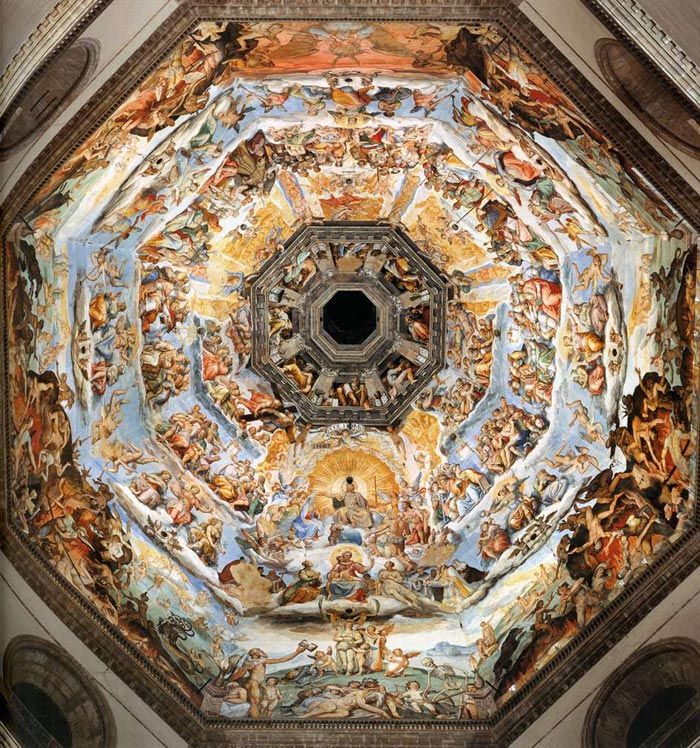 |
||
Giorgio Vasari, The Last Judgment (detail), 1572-79, fresco, Duomo, Florence |
||
| Domes, which vault the crossing and altar of countless churches, lend themselves well to being transformed into paintings of the sky. The round shape above our heads seems to open onto a higher world, so that God and the things of heaven become visually present at the church holiest spot. The Last Judgment in the enormous dome of the cathedral in Florence was painted from 1572 onward. Vincenzo Borghini had drawn up a learned theological program as early as 1570, Giorgio Vasari was responsible for executing it, but he died in 1574. Federico Zuccaro completed the frescoes in 1575-79. High up in the fresco in the dome, around the cupola, hovers a temple with the twenty-four elders of the Apocalypse; beneath this, on terraced registers, follow choirs of angels with the instruments of the Passion, then groups of saints, then personifications of the gifts of the Holy SXpirit, of the virtues, and of the beatitudes, and finally the regions of hell with various deadly sins. The composition of the fresco thus takes into account the architectonic form of the vault in its eight sections, hard upon one another. There is no attempt to dissolve the architectural structure completely by means of illusionistic painting. The temple and the zones of heaven for four of the eight sections of the vault were completed under Vasari's direction. |
||
|
||
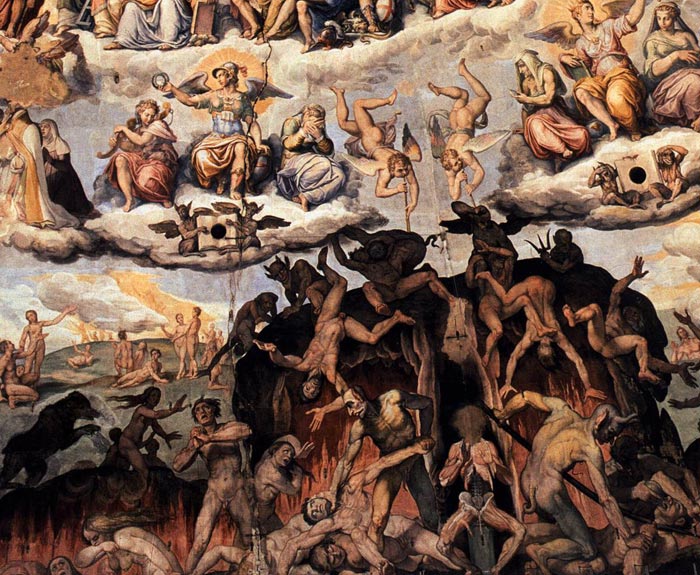 |
||
Giorgio Vasari, The Last Judgment (detail), 1572-79, fresco, Duomo, Florence |
||
| Italian Renaissance painting | ||||||||||||||||||||||||||||||||
|
||||||||||||||||||||||||||||||||
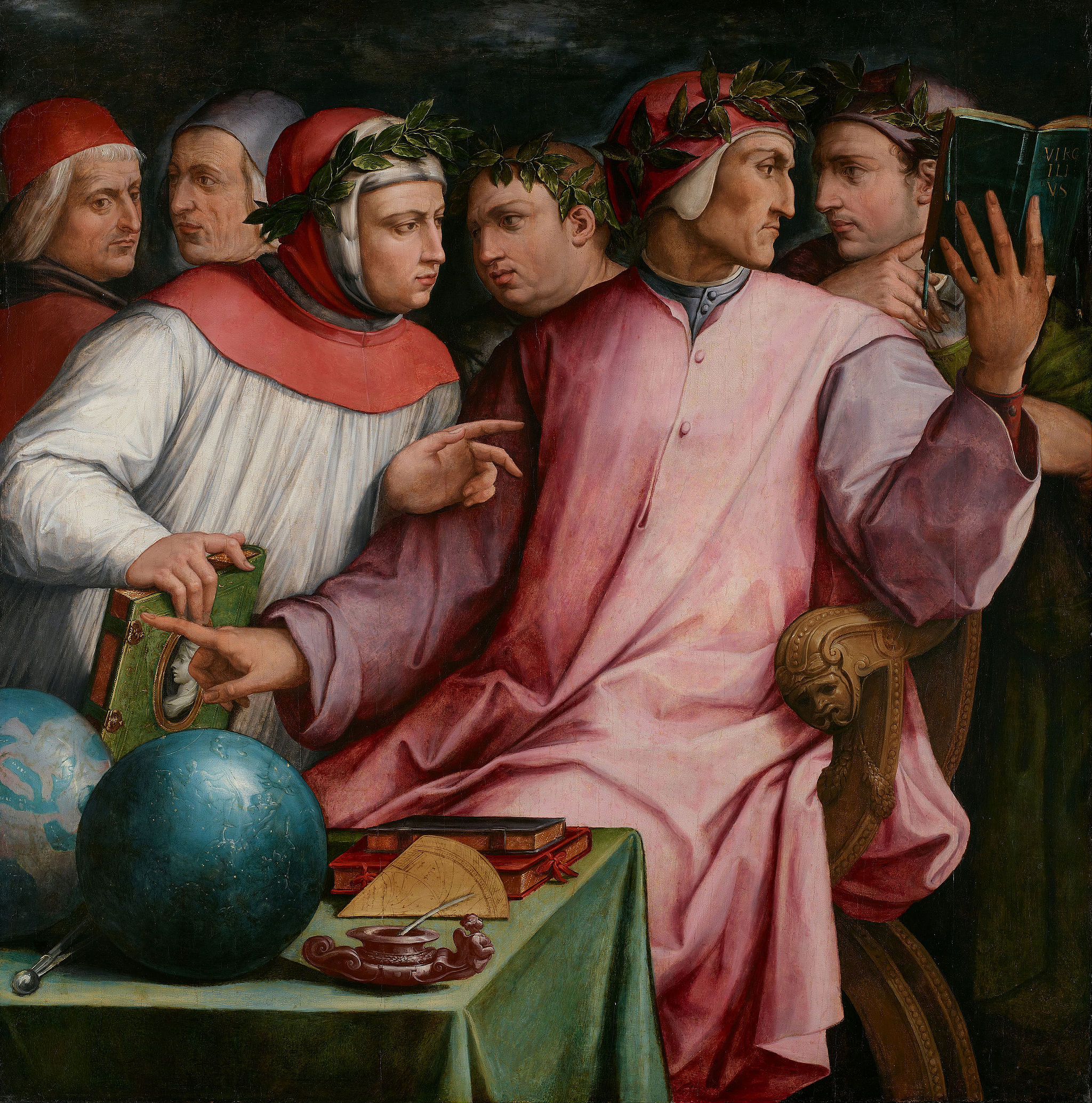 |
||||||||||||||||||||||||||||||||
Giorgio Vasari, Six Tuscan Poets, c. 1544. From left to right: Marsilio Ficino, Cristoforo Landino, Francesco Petrarch, Giovanni Boccaccio, Dante Alighieri and Guido Cavalcanti.[2]
|
||||||||||||||||||||||||||||||||
Art in Tuscany | Art in Tuscany | Giorgio Vasari | Lives of the Most Excellent Painters, Sculptors, and Architects Persistence and fashion in art | Italian Renaissance from Vasari to Berenson and beyond
Travels with Vasari |
||||||||||||||||||||||||||||||||
BBC - Travels with Vasari Part 1, 1-4
|
||||||||||||||||||||||||||||||||
|
||||||||||||||||||||||||||||||||
Podere Santa Pia |
Podere Santa Pia, giardino |
Cypress trees between San Quirico d'Orcia and Montalcino, one of the bird trapping techniques to capture wild birds. |
||||||||||||||||||||||||||||||
Villa I Tatti |
Bagni San Filippo |
|||||||||||||||||||||||||||||||
Palazzo Medici Riccardi, Florence |
Piazza della Santissima Annunziata in Florence |
Florence, Duomo |
||||||||||||||||||||||||||||||
Casa Vasari in Florence |
||||||||||||||||||||||||||||||||
| Museo di Casa Vasari in Arezzo In 1540 Vasari bought the house situated in Via XX Settembre, 55 when it was still being built. He himself was responsible for the project, the decorations and furnishings and today is a good example of Tuscan mannerist style. In 1548 the two-storey house was ready and in 1550 was all complete in its details when he married Nicolosa Bacci. But Vasari couldn't live there for long, as he constantly had to move to Florence and Rome, following his protectors' wishes and carrying out his works. In 1554 Vasari definitevely settled in Florence with his wife where he lived for twenty years, till his death. In this house he used to keep his collection of works of art. The house was enlarged in the XIXth century and was used as a private residence until last century. |
||||||||||||||||||||||||||||||||
| Uffizi Gallery in Florence | ||||||||||||||||||||||||||||||||
| The greatest art gallery in Italy is one of the largest museums in the world covering an area of about 8.000 sq.m.and a fitting memorial to the town's importance as the cradle of the Renaissance, this art museum contains one of the greatest collections of paintings in existence. It was built in the mid-sixteenth century, following a project by the architect Giorgio Vasari and still houses some of the most famous works of art by Italian and foreign painters from the 13th to 19th centuries, such as Tiziano, Cimabue, Giotto, Masaccio, Tintoretto, Leonardo, Botticelli, Michelangelo, Piero della Francesca, Raffaello, Caravaggio, Rubens, Rembrandt, Durer and Goya. The Gallery of the Uffizi was also the first museum ever to be opened to the public: in fact the Grand Duke granted permission to visit it on request from the year 1591. Its four centuries of history make the Uffizi Gallery the oldest museum in the world. Building of the palace was commenced in 1560 by Giorgio Vasari for Cosimo I de' Medici as the offices for the Florentine magistrates ? hence the name uffizi, meaning offices. Construction work ended in 1581. Over the years, parts of the palace evolved into a storage place for many of the works of art collected by the Medici family. After the decline of the Medici, the art treasures remained in Florence, forming one of the first modern museums. The gallery had been open to visitors on request since the 16th century and in 1765 it was officially opened to the public. Because of its huge collection, some of its works have in the past been transferred to other museums in Florence, such as some famous statues to the Bargello. In 1993, a car bomb exploded in Via dei Georgofili and damaged parts of the palace, killing five people. The most severe damage was to the Niobe room, the classical sculptures and neoclassical interior of which have been restored, although its frescoes were beyond repair. The cause has never been cleared up, although some suspect the Mafia. Today, the Uffizi is one of the most popular tourist attractions of Florence. |
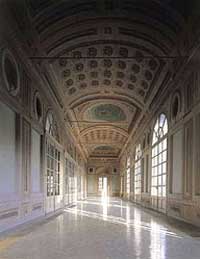 |
|||||||||||||||||||||||||||||||
Collections
Address: Piazzale degli Uffizi, 50122 Firenze
|
||||||||||||||||||||||||||||||||
Wikimedia Commons has media related to Giorgio Vasari. |
||||||||||||||||||||||||||||||||

